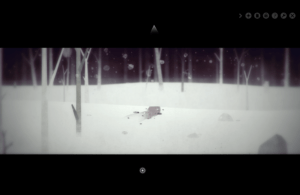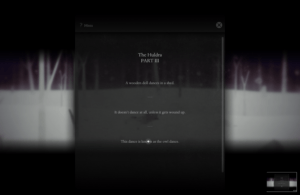Year Walk is a first-person adventure walking sim developed and published by Simogo, an independent Swedish video game developer. The game is based on a Swedish folk phenomenon called Årsgång — which translates to “year walk”— where “year walkers” were said to be given glimpses of the future after completing challenges and following certain instructions on New Year’s Eve. Year Walk is considered a horror game and is listed on the App Store as suitable for ages 12+. It was originally published for iOS devices in 2013 and is now available on various platforms, including Windows, OS X, and Wii U.
 When you are first dropped into the world of Year Walk, you might feel a sense of annoyance — your perspective is letterboxed, you can only really move left and right (with occasional prompted opportunities to move north and south), you can’t look up, down, and around. You could say that the game feels like it’s made of several rows of horizontal screens that occasionally have doorways you can get through to see another screen. Each screen has a boundary, thus as a player, whenever you reach the left-most or right-most end, you know that you need to find some other direction to go to—a form of indirect guidance from the game developers and a very smart choice as endless horizontal screens would be horrifying. In a sense, the game limits your perspective and there is a type of primitiveness created by how your own movement is portrayed through mere sliding screens and zoom transitions — as opposed to an open-world game environment where there is a sense of fluidity. When you first start playing the game, guidance when navigating feels too limited. For instance, you are occasionally shown arrows when you have the option to move north or so
When you are first dropped into the world of Year Walk, you might feel a sense of annoyance — your perspective is letterboxed, you can only really move left and right (with occasional prompted opportunities to move north and south), you can’t look up, down, and around. You could say that the game feels like it’s made of several rows of horizontal screens that occasionally have doorways you can get through to see another screen. Each screen has a boundary, thus as a player, whenever you reach the left-most or right-most end, you know that you need to find some other direction to go to—a form of indirect guidance from the game developers and a very smart choice as endless horizontal screens would be horrifying. In a sense, the game limits your perspective and there is a type of primitiveness created by how your own movement is portrayed through mere sliding screens and zoom transitions — as opposed to an open-world game environment where there is a sense of fluidity. When you first start playing the game, guidance when navigating feels too limited. For instance, you are occasionally shown arrows when you have the option to move north or so uth, otherwise you can only move straight west or straight east. Moreover, there aren’t really any instructions or an extended sense of a tutorial; rather you are told basic ways to move about your environment, and then you are supposed to figure it out on yourself. If a player feels stuck though, there are hints hidden away in the menu bar that you can access if you stumble upon them, which I didn’t end up doing for a good amount of time. At several points, I thought to myself “I wish I had a map” and “I don’t know where I am.” (Turns out there is also a map hidden away in the menu). But the limited use of tutorials, and instructions felt like a purposeful decision from the game developers to preserve the imaginative and creative experience of reading, hearing, or watching a story unfold. Thus, by maintaining game mechanics that appear to be simplistic as well as very rudimentary options for movement and interactions, Year Walk becomes the perfect environment for players to be creative, use their imagination, and explore while also having a sense of optional structure for their gameplay experience.
uth, otherwise you can only move straight west or straight east. Moreover, there aren’t really any instructions or an extended sense of a tutorial; rather you are told basic ways to move about your environment, and then you are supposed to figure it out on yourself. If a player feels stuck though, there are hints hidden away in the menu bar that you can access if you stumble upon them, which I didn’t end up doing for a good amount of time. At several points, I thought to myself “I wish I had a map” and “I don’t know where I am.” (Turns out there is also a map hidden away in the menu). But the limited use of tutorials, and instructions felt like a purposeful decision from the game developers to preserve the imaginative and creative experience of reading, hearing, or watching a story unfold. Thus, by maintaining game mechanics that appear to be simplistic as well as very rudimentary options for movement and interactions, Year Walk becomes the perfect environment for players to be creative, use their imagination, and explore while also having a sense of optional structure for their gameplay experience.



